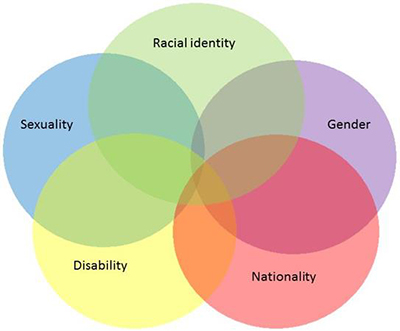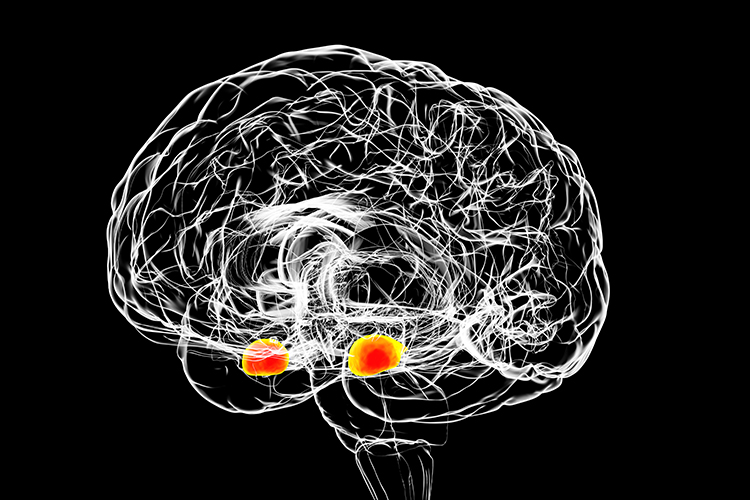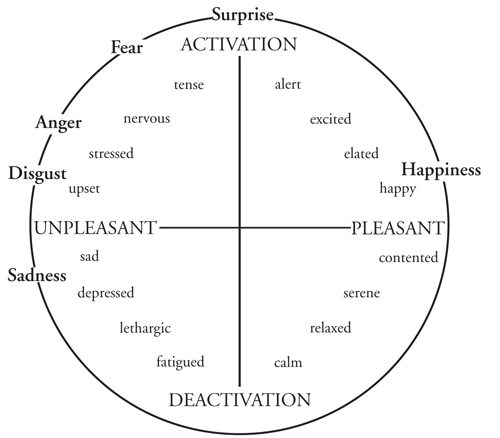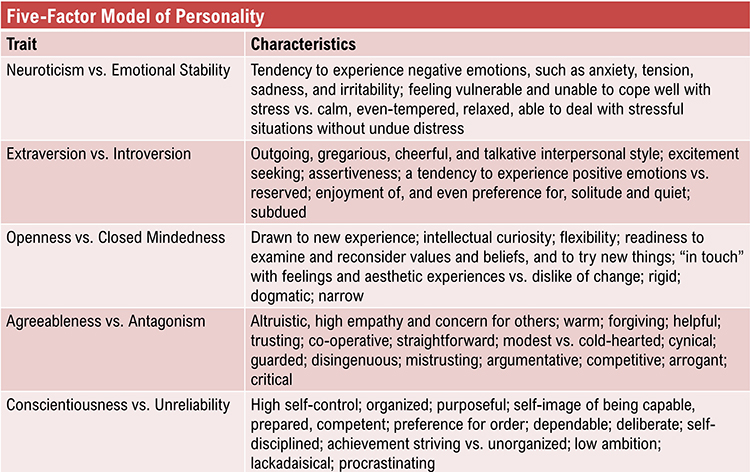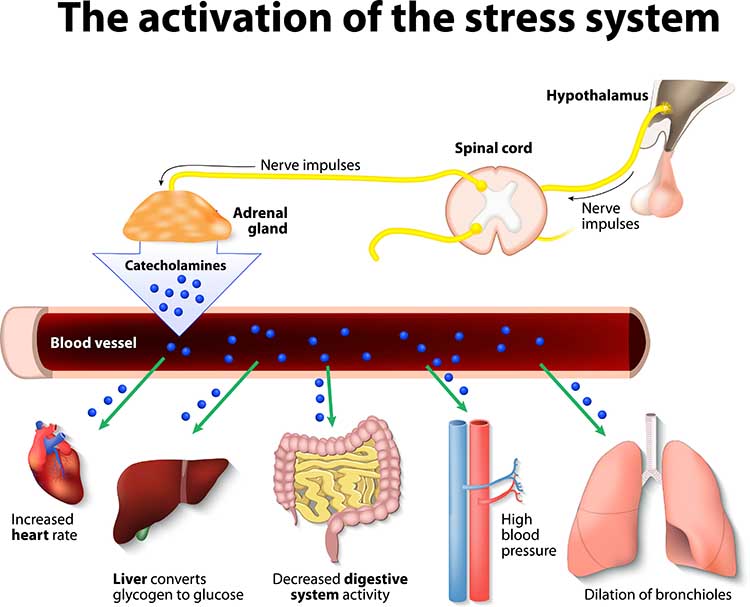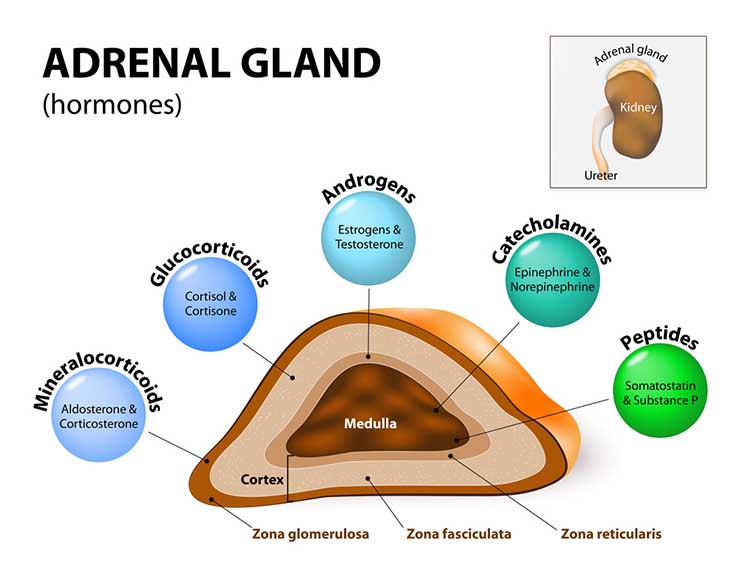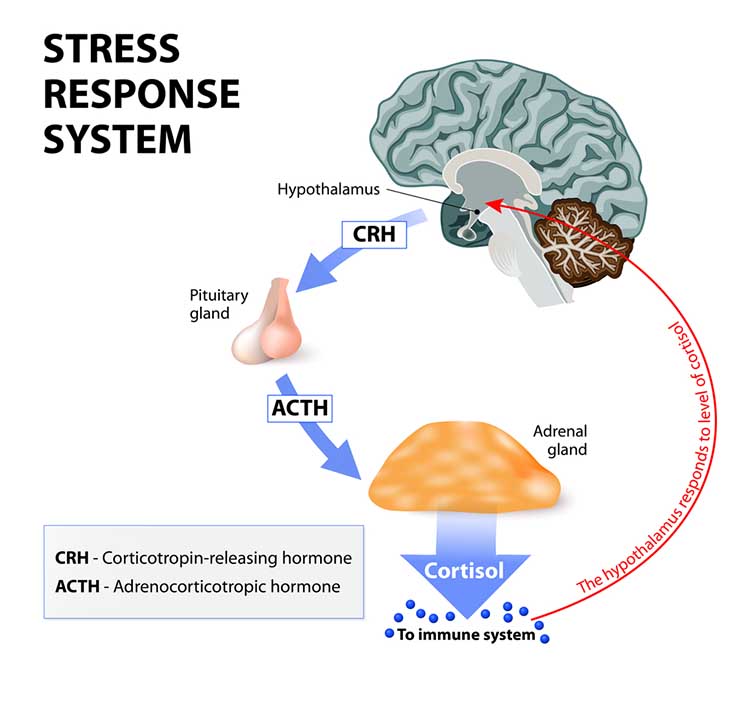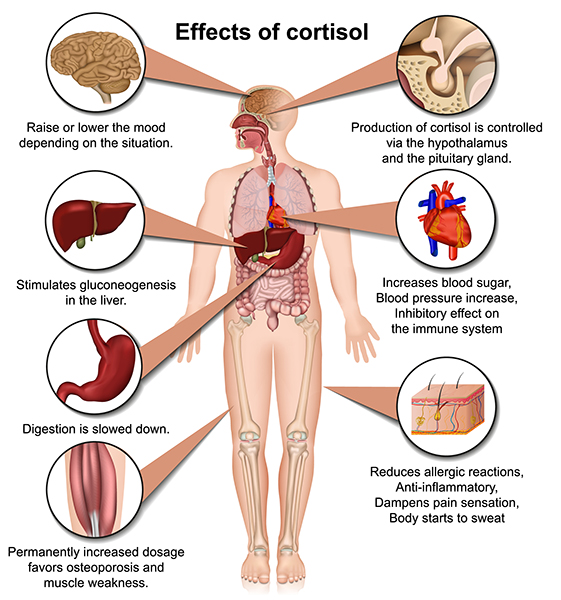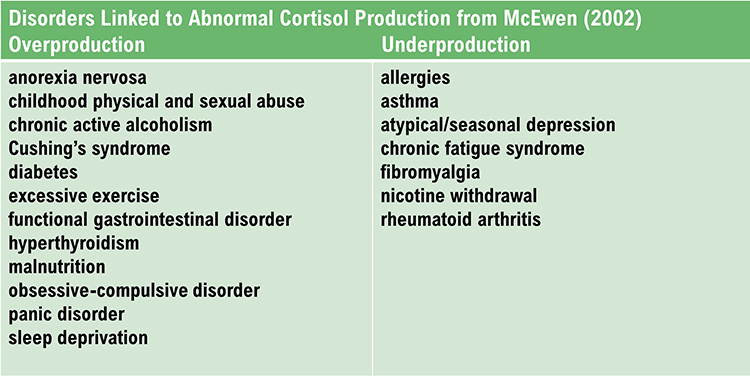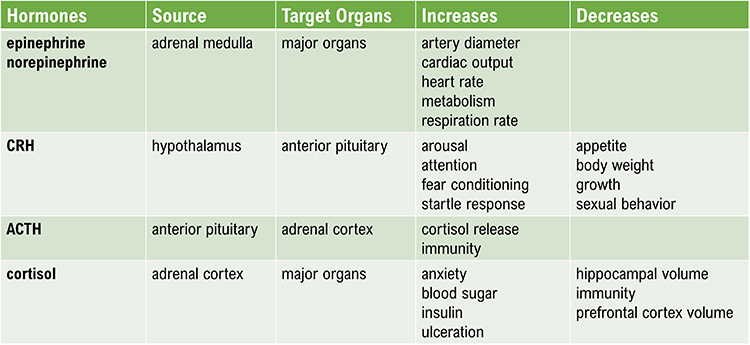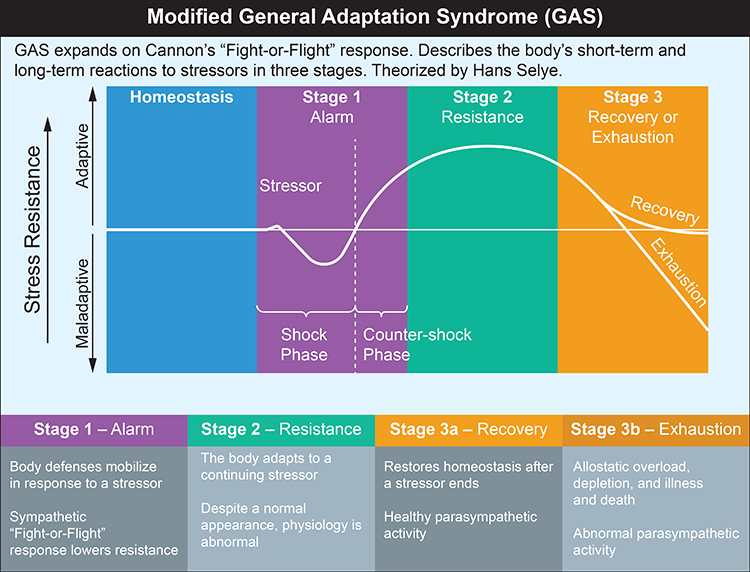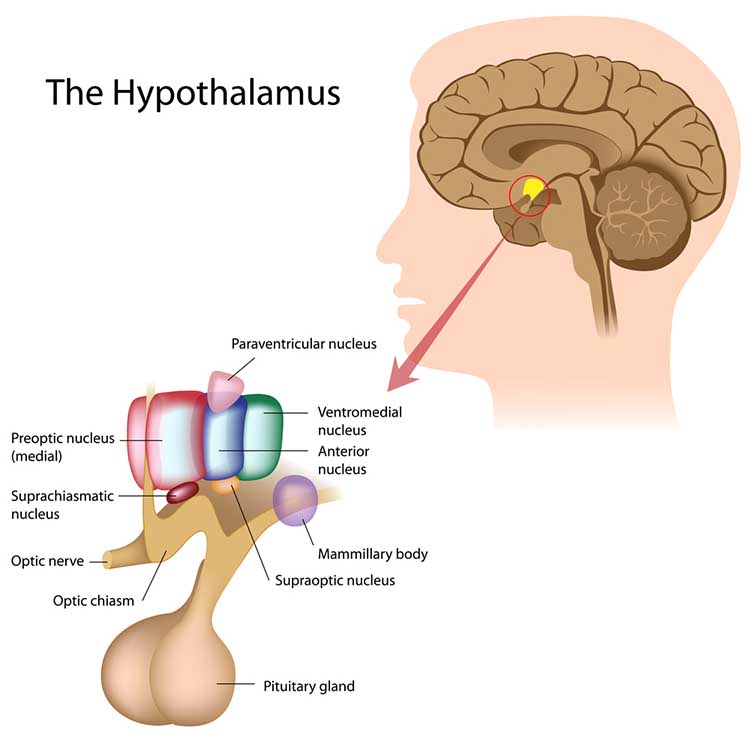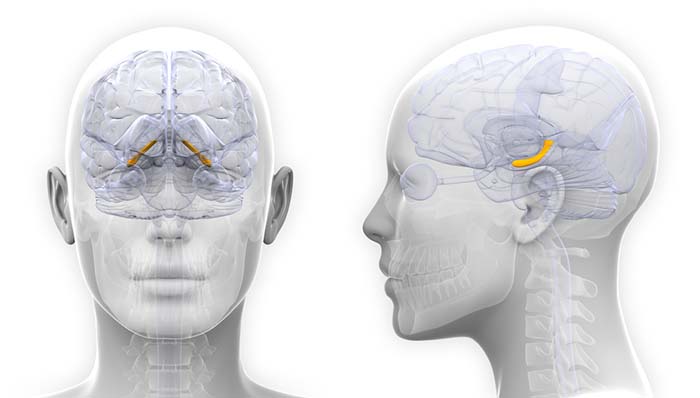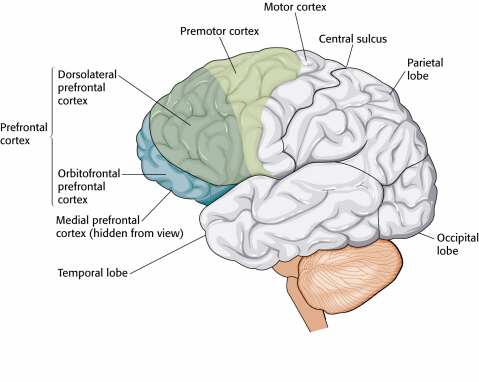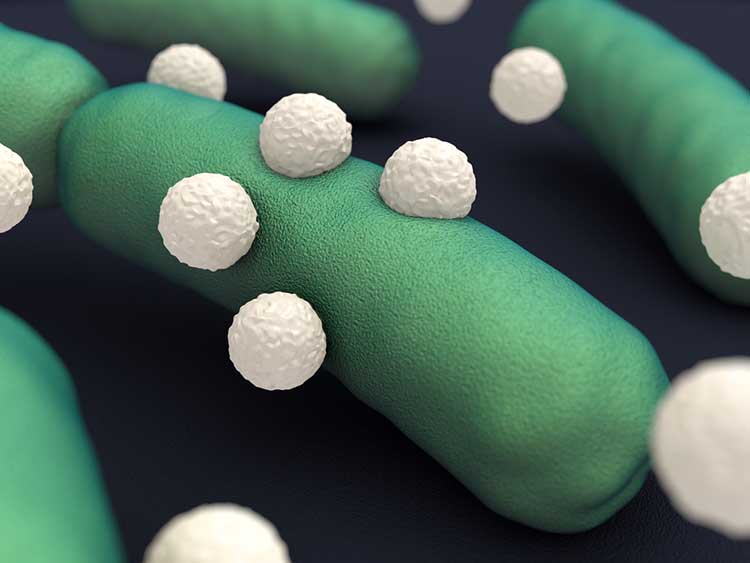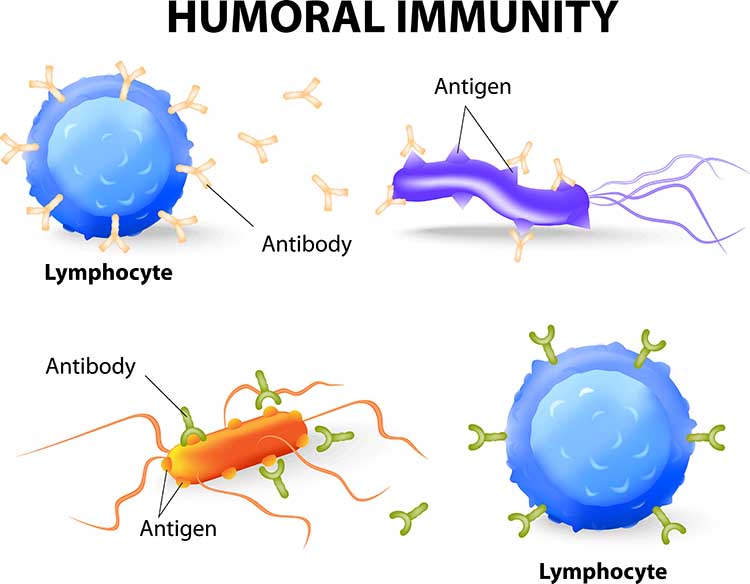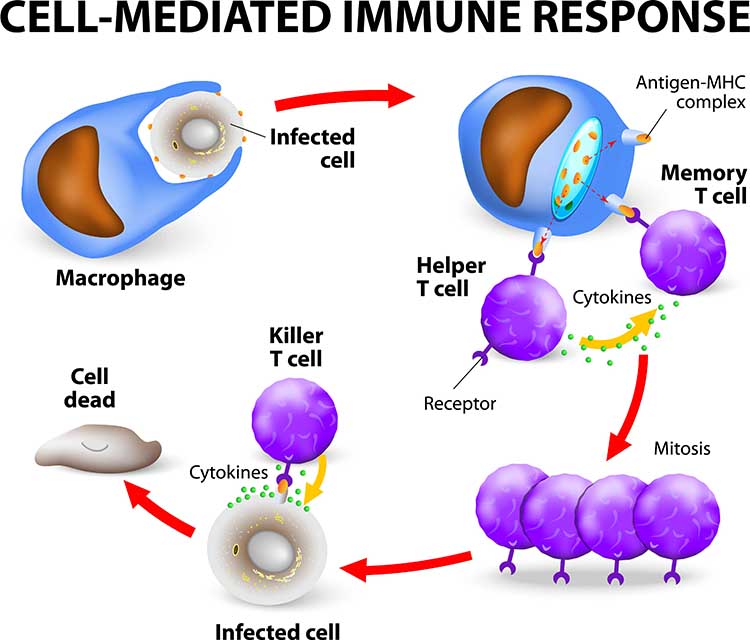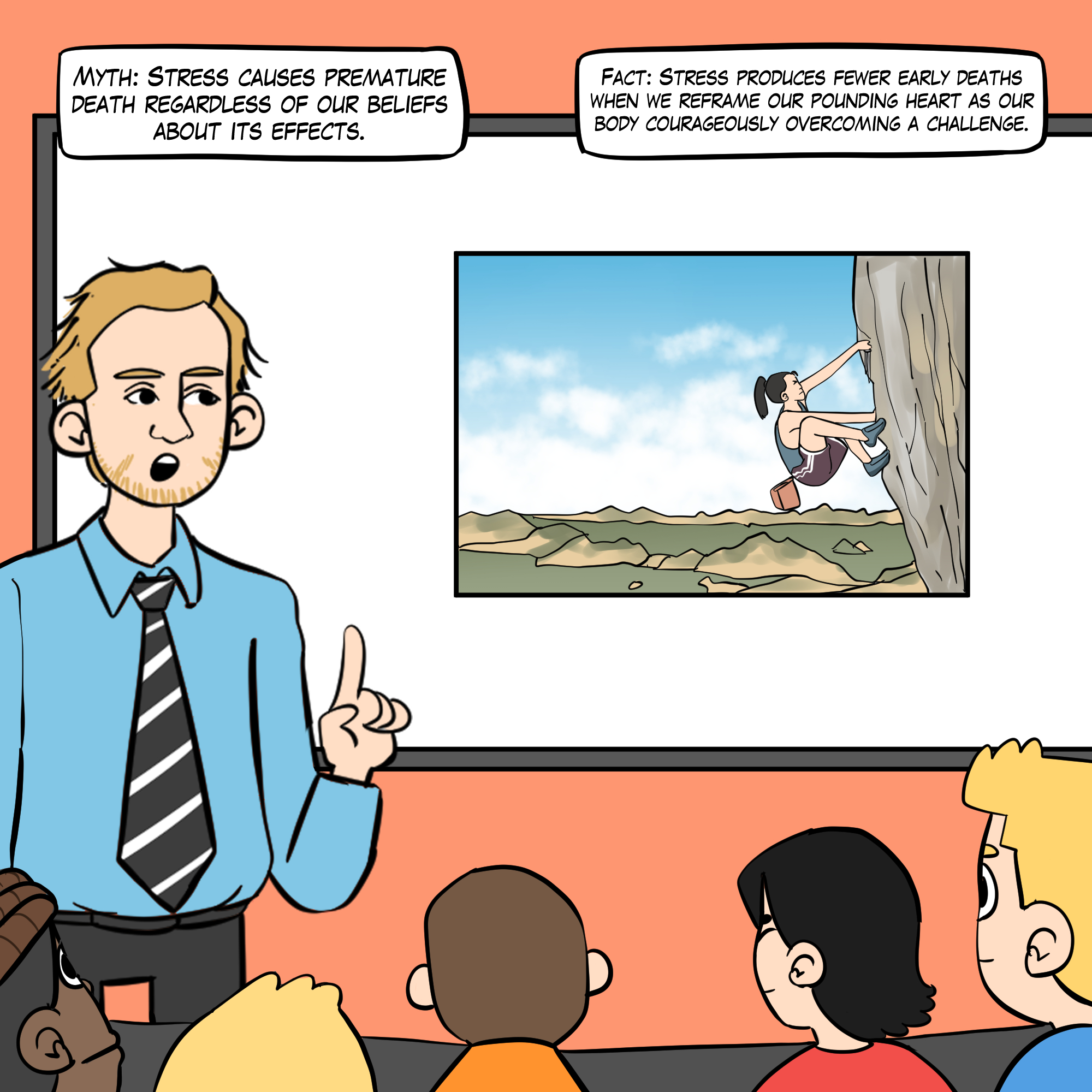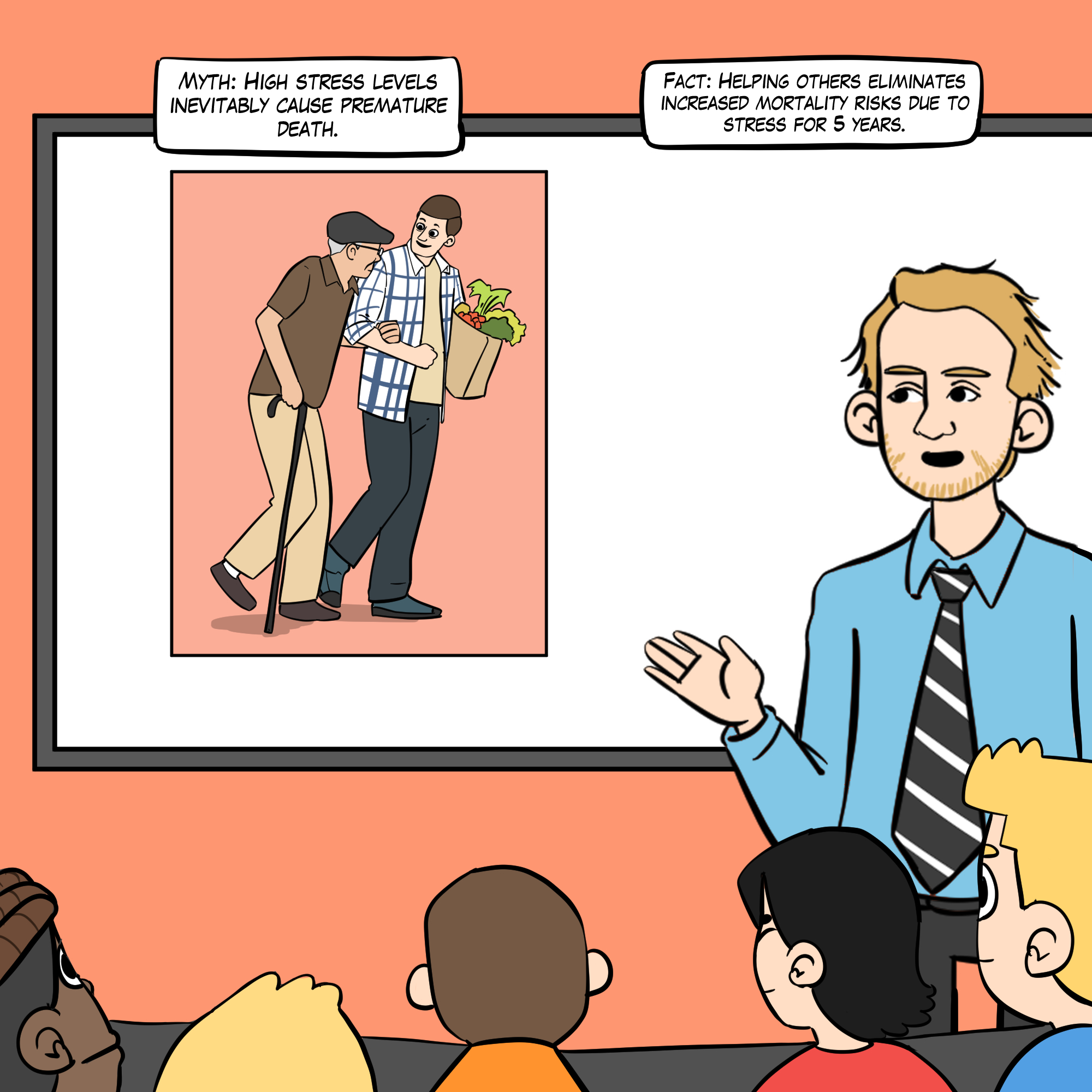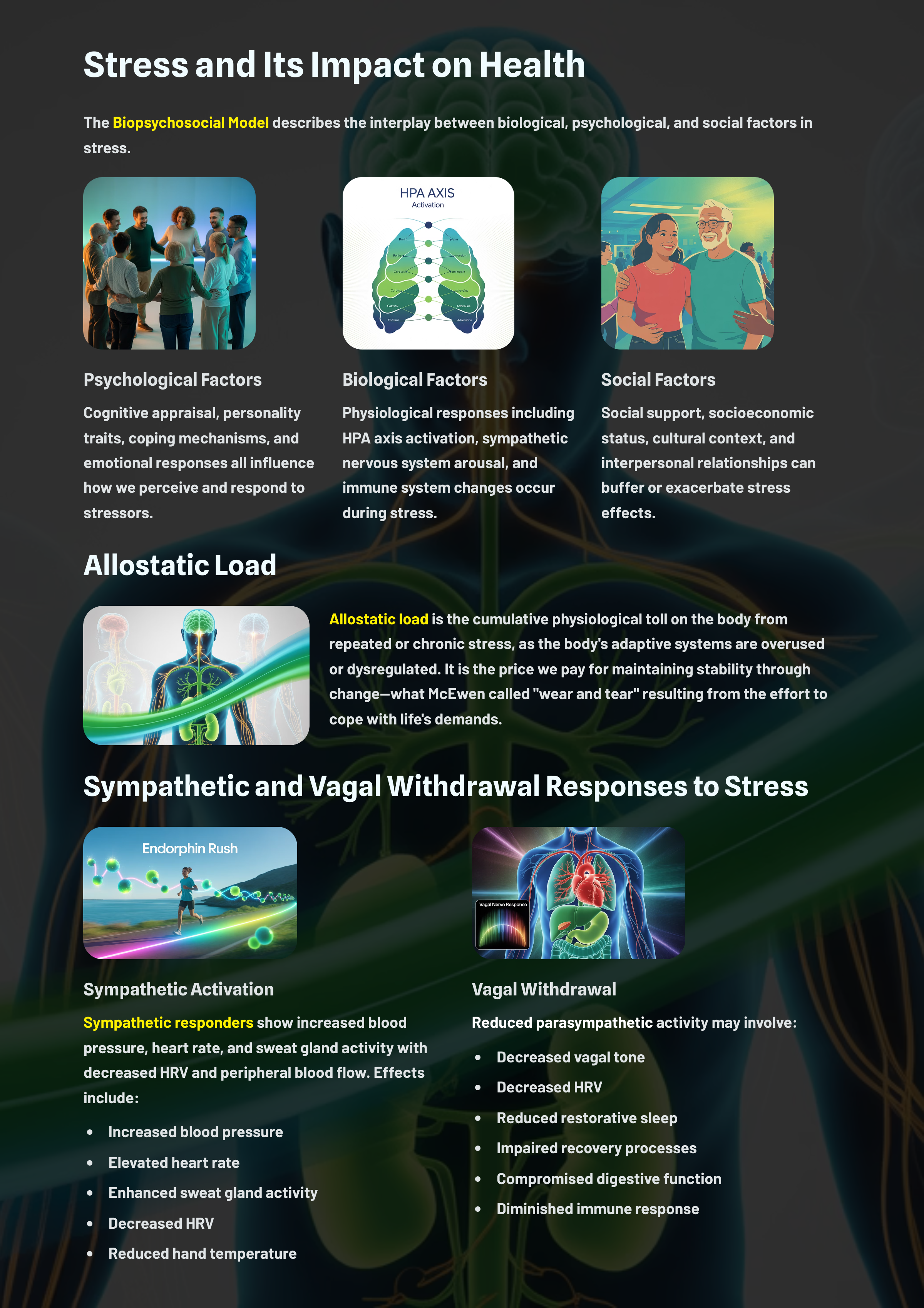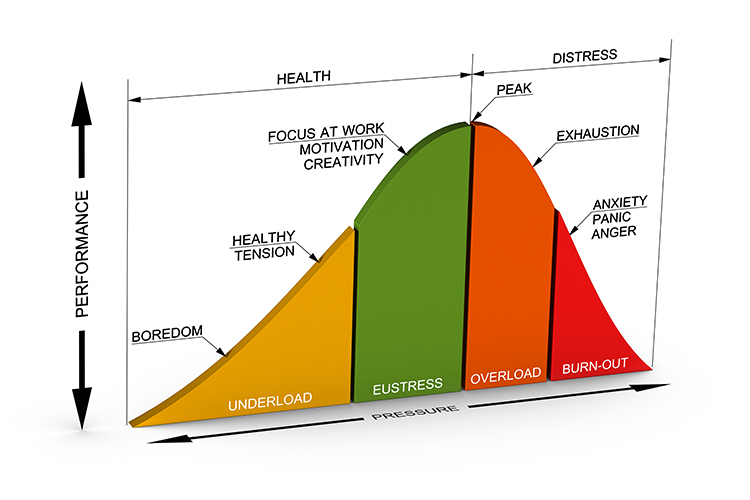
Stress
Stress can be confusing since it can refer to a stimulus, response, a transaction. The stress response is multidimensional, there are multiple stress responses, and individuals often show a characteristic response pattern. The conceptualization of the stress response as nonspecific is misleading since clients may have unique stress triggers (time pressure) and specific psychophysiological changes (blood pressure spikes).
While early theories of stress emphasized the role of stimuli, more recent theories focus on our cognitive appraisal of events and coping resources. The biopsychosocial model has replaced the aging biomedical model due to its greater comprehensiveness and support for interdisciplinary treatment of disorders. Likewise, the allostatic load model has replaced Selye's General Adaptation System framework for understanding the role of stress in disease. Graphic © Arseniy Krasnevsky/Shutterstock.com.

Chronic stress reduces heart rate variability (HRV). "HRV is the organized fluctuation of time intervals between successive heartbeats defined as interbeat intervals" (Shaffer, Meehan, & Zerr, 2020). We measure the time intervals between successive heartbeats in milliseconds. Graphic adapted from Dr. Richard Gevirtz.

HRV is crucial to health, performance, and resilience. Low HRV is a marker for cardiovascular disorders, including hypertension, especially with left ventricular hypertrophy; ventricular arrhythmia; chronic heart failure; and ischemic heart disease (Bigger et al., 1995; Casolo et al., 1989; Maver et al., 2004; Nolan et al., 1992; Roach et al., 2004). Low HRV predicts sudden cardiac death, particularly due to arrhythmia following myocardial infarction and post-heart attack survival (Bigger et al., 1993; Bigger et al., 1992; Kleiger et al., 1987).
Reduced HRV may predict disease and mortality because it indexes reduced regulatory capacity, which is the ability to surmount challenges like exercise and stressors. Patient age may be an essential link between reduced HRV and regulatory capacity since HRV and nervous system function decline with age (Shaffer, McCraty, & Zerr, 2014).
BCIA Blueprint Coverage
This unit addresses Models of stress and illness (II-A), Psychophysiological reactions to stressful events (I-B), and Psychosocial mediators of stress (I-C).

This unit covers Stressors and Stress, The Stress Response is Multidimensional, Biopsychosocial Model, Allostatic Load Model, Stress-Diathesis Model, System-Wide Effects of Stress, Stressful Life Events, Psychological Factors in Stress, Acute and Chronic Stress Responses, Psychoneuroimmunology, Cognitive Appraisal of Stressors and Coping, Personality Dimensions, and Resources to Buffer Stress.
Please click on the podcast icon below to hear a full-length lecture.

Stressors and Stress
Cannon (1939) studied how environmental stressors like cold temperatures and loss of oxygen trigger a fight-or-flight response. He conceptualized stress as the disruption of homeostasis when the body mobilizes the sympathetic and endocrine systems to deal with external threats.

Selye (1956) also studied environmental challenges to homeostasis. He referred to stress (and strain) as emotional and physiological responses to stimuli called stressors.
Listen to a mini-lecture on Stressors and Stress © BioSource Software LLC.
Selye conceptualized stress as a nonspecific response.
Selye conceptualized these responses as nonspecific since many stimuli can produce the same physiological changes. He theorized that negative and positive stimuli could provoke stress responses requiring coping resources. He termed stress due to aversive stimuli, distress, and positive events, as eustress (Moksnes & Espnes, 2016).

Evaluation
Selye's model excluded psychological factors like appraisal. His assumption that stress involves nonspecific physiological changes is incorrect. All stressors do not produce a uniform endocrine stress response. Instead, stressors can change multiple body systems in response to stressor intensity, biological predisposition, cognitive appraisal, perceived support, and emotional response (Mason, 1971, 1975; McEwen, 2005; Taylor, 2021). Finally, whereas Selye proposed that our stress responses attempt to maintain physiological processes within a narrow optimal range, current research focuses on adaptation (e.g., allostatic load model) instead of set points (Brannon et al., 2022).
The Stress Response Is Multidimensional
The human stress response is multidimensional and involves diverse systems, from the central nervous system to the immune system. Each person uniquely responds to stressors. This individualized pattern is called response stereotypy. Individuals differ in the systems impacted, their activation or suppression, and how these changes affect health. While stressors can produce system-wide macroscopic changes like increased blood pressure, they can also cause epigenetic changes that alter DNA expression. Graphic © Sergey Nivens/Shutterstock.com.
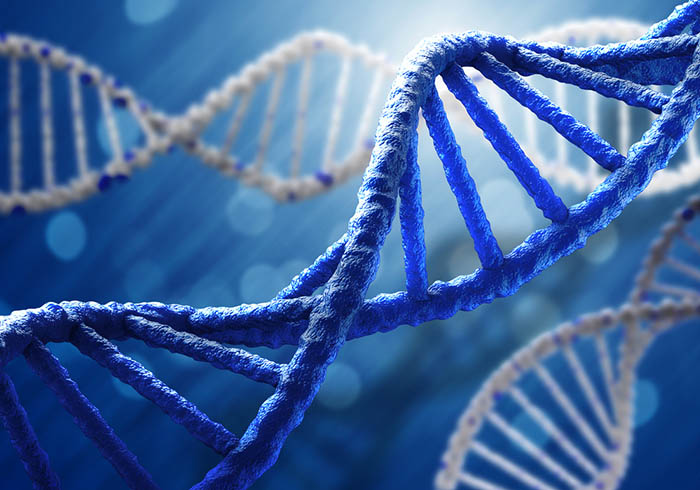
Sympathetic and Parasympathetic Responders
Two modal patterns of autonomic response to stressors have been observed. A sympathetic responder may
increase blood pressure, heart rate, and sweat gland activity and decrease heart rate variability and peripheral
blood flow. These changes may result from increased sympathetic activation, decreased parasympathetic
activation called parasympathetic withdrawal, or a combination of both. Listen to a mini-lecture on Sympathetic and Parasympathetic Responders © BioSource Software LLC.
In contrast, a parasympathetic responder may increase digestive activity, constrict the lungs' alveoli, and faint from low blood pressure.
Individuals can react to stressors with elements of both autonomic patterns. For example, they can increase heart rate and blood pressure (sympathetic) while experiencing the gastrointestinal symptoms of diarrhea and gas (parasympathetic).

Hawks and Doves
Individuals differ in their behavioral activation when confronted by a stressor. While behavior is activated in the "fight-or-flight" response, it is suppressed in the "freeze-hide" response. The dazed young man illustrates passive parasympathetically-mediated freezing. Graphic © Dean Drobot/Shutterstock.com.
Evolutionary biologists have called active and passive responses "hawk" and "dove" strategies. Graphic © jimkruger/ iStockphoto.com.

Hawks are described as "proactive and bold," while doves are passive, reactive, nonaggressive, and cautious. Hawks appear to utilize the "fight-or-flight" response and activate the sympathetic-adrenomedullary (SAM) pathway. Doves, in contrast, activate the hypothalamic-pituitary (HPA) axis (Woolfolk et al., 2007).
Men and women may respond differently to stressors. Studies of hormonal secretion during sports competition (Kivlinghan et al., 2005) and children's reactions to threatening behavior by their mothers (David & Lyons-Ruth, 2005) support the hypothesis that men are more likely to flee while women prefer to affiliate. Graphic © lassedesignen/Shutterstock.com.

Stress-related disorders are more prevalent in women than men in the US (Gaidos, 2016).
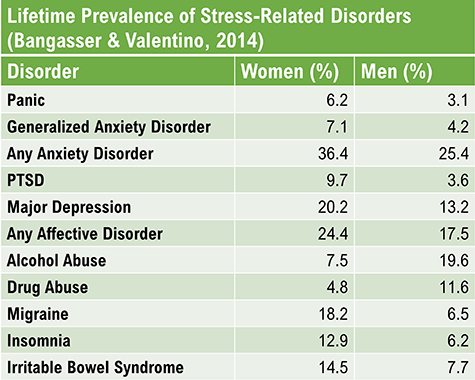
Corticotropin-Releasing Hormone (CRH)
The stress hormone corticotropin-releasing hormone or factor (CRH/CRF) is a hormone and neurotransmitter. Threats and intense emotional responses cause the brain to secrete CRH to increase attention and mobilize to cope with a threat. The brain releases CRH at the prefrontal cortex (attention and executive functions), the amygdala (anxiety, fear, and emotional memories), and the hippocampus (declarative memories). The hormones estrogen and progesterone in females and testosterone in men may influence the brain's response to CRH.Bangasser (2013) reported evidence from studies with rodents that males reduce the number of postsynaptic CRH receptors following a stressor while females do not. Female rodents' brains are more responsive to elevated CRH levels, and this prolonged response may result in hypervigilance. Chronic high levels of stress hormones can modify DNA via epigenetic mechanisms (like DNA methylation) to increase vulnerability to disorders like anxiety and depression (Gaidos, 2016).
Oxytocin
The medioventral bed nucleus of the stria terminalis (near the hypothalamus) regulates anxiety and teaches us to avoid stress-related locations or situations. When strangers bully female rodents, they increase the number of oxytocin-secreting neurons and oxytocin levels in the stria terminalis. Following stressful events, oxytocin may increase anxiety to a greater degree in female than male rodents. Women diagnosed with PTSD have elevated plasma levels of oxytocin (Gaidos, 2016).Neurosecretory cells in the hypothalamus synthesize oxytocin released by terminals located in the posterior pituitary (Breedlove & Watson, 2020). Graphic © Designua/Shutterstock.com.
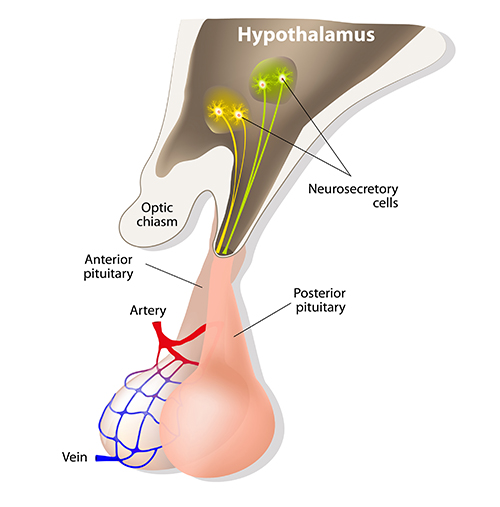
Biopsychosocial Model
Engel's (1977, 1980) biopsychosocial model proposes that the complex interplay of psychological, biological, and sociological factors results in health or illness.

In this model, stress is a psychological risk factor that affects and is influenced by an individual's biology and sociology. The biopsychosocial model challenges the biomedical model that illness is primarily due to biological abnormalities, which has influenced medical practice since the 1700s (Taylor, 2012). A clinician who adopts the biopsychosocial model assumes that health depends on all three factors. When treating illness, these factors must be assessed and addressed using an interdisciplinary approach (Schwartz, 1982).
The illustration below was adapted from Brannon et al. (2022).
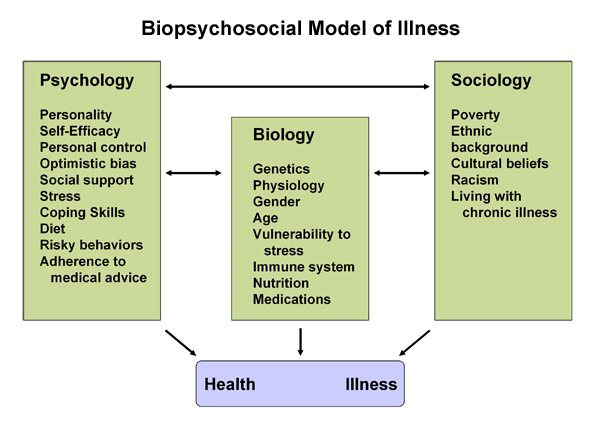
Evidence supporting the biopsychosocial model includes increased psychological and medical disorders in divorced and bereaved persons (Schneider, 1984).
Allostatic Load Model
Allostasis, which means achieving stability through change, involves matching type (sympathetic or parasympathetic) and intensity of physiological activation to situational demands (Brannon et al., 2022).
McEwen and Seeman's (1999) allostatic load model proposes that biological responses to stress (e.g., cortisol secretion or elevated glutamate transmission) can harm the body when stressors are acute or repeatedly occur. Over time, the stress response itself may overwhelm the body's adaptive capacity.

Caption: Bruce McEwen

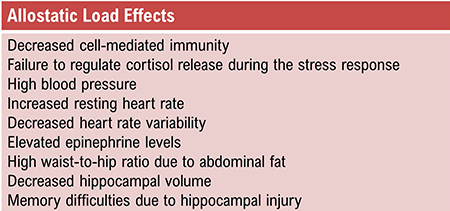
Researchers have linked high allostatic load to illness in children and the elderly (Johnston-Brooks et al., 1998; Seeman et al., 1997). The damage produced by allostatic load can be amplified by decreased healthy behaviors (e.g., exercise) and increased unhealthy behaviors (e.g., binge drinking and smoking) (Ng & Jefferey, 2003).
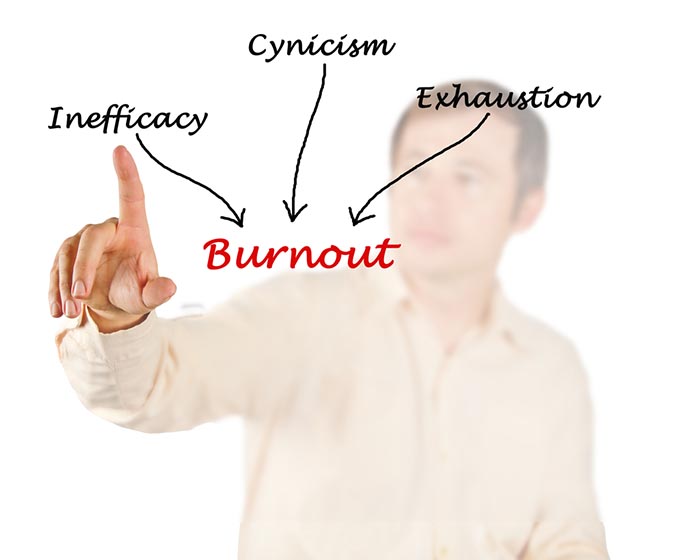
Check out Sapolsky's superb National Geographic YouTube video Stress, Portrait of a Killer.
Stress-Diathesis Model
The stress-diathesis model explains that stressors interact with our inherited or acquired biological vulnerabilities, diatheses, to produce medical and psychological symptoms. From this perspective, disease results when an individual is predisposed to disease and experiences stress. Life event scales like the SRRS and USQ may achieve low predictive validity because they only and incompletely assess stress; they do not evaluate illness vulnerability (Marsland et al., 2001).
The interrelationship between stress, insomnia, and depression illustrates the stress-diathesis model. Sleep reactivity, the tendency for sleep to be disrupted by stress, appears to be a shared vulnerability in insomnia and depression. Greater sleep reactivity produces insomnia, and insomnia contributes to depression. Chronic insomnia can also increase blood pressure, blood sugar levels, and weight (Drake et al., 2014).
System-Wide Effects of Stress
Stress and the Microbiome
The human microbiome encompasses the collective genomes of trillions of microorganisms residing in and on the human body, including bacteria, viruses, fungi, and protozoa. The ratio of human cells to microbiota, including bacteria, fungi, and viruses, is approximately 1:1. This challenges the previously held belief that microbes outnumber human cells by a ratio of 10:1 (Sender, Fuchs, & Milo, 2016).These microbial communities inhabit various niches such as the skin, oral cavity, gastrointestinal tract, and urogenital regions, playing crucial roles in maintaining health by aiding digestion, modulating the immune system, and protecting against pathogens. Graphic © Kateryna Kon/Shutterstock.com.
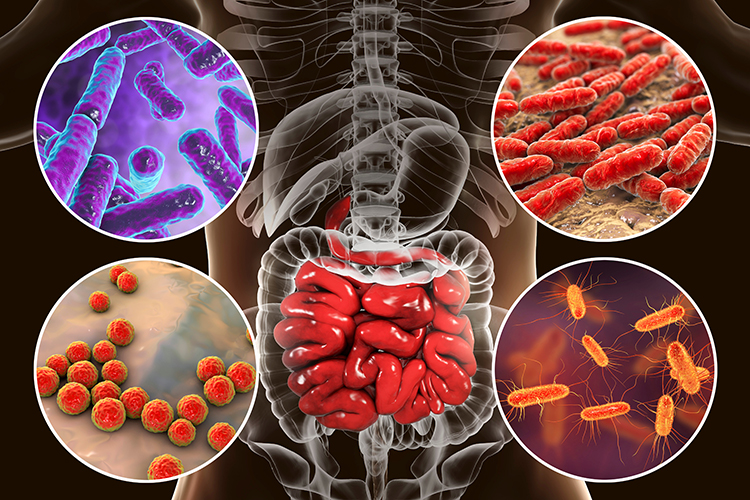
Researchers have proposed distinct blood, brain, and vaginal microbiomes.
Blood Microbiome
Traditionally, blood has been considered a sterile environment. However, recent studies suggest the presence of a low-biomass microbiome in the bloodstream, potentially originating from translocated gut microbes or oral pathogens. The composition and implications of this blood microbiome are still under investigation, with some research indicating associations with systemic diseases.Brain Microbiome
The central nervous system (CNS) has long been regarded as a sterile site due to the protective blood-brain barrier. Emerging research proposes that microbial components or metabolites may influence CNS function indirectly through systemic circulation or the vagus nerve, rather than a resident brain microbiome. The concept of a direct brain microbiome remains controversial and is an active area of research.Vaginal Microbiome
The vaginal microbiome is predominantly composed of Lactobacillus species, which maintain an acidic environment (pH 3.5-4.5) that inhibits pathogenic organisms. Disruptions in this microbiome can lead to conditions such as bacterial vaginosis, characterized by a decrease in Lactobacillus and an increase in anaerobic bacteria, potentially increasing susceptibility to infections and adverse reproductive outcomes.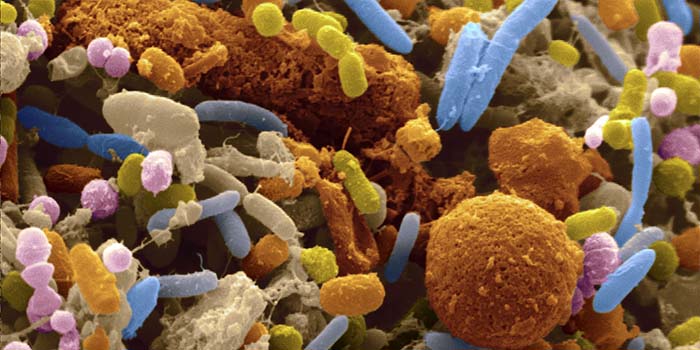
The Microbiome Modulates Neurotransmitters
The gut microbiota communicates with the brain through the microbiota-gut-brain axis, influencing neurotransmitter production, transportation, and function, which in turn affects cognitive functions and brain activity (Chen, Xu, & Chen, 2021; Lynch & Hsiao, 2023).Key neurotransmitters such as dopamine, serotonin, and gamma-aminobutyric acid (GABA) are modulated by gut bacteria, which can produce or alter these neuroactive compounds, impacting host physiology and potentially contributing to conditions like Parkinson's disease, anxiety, and depression (Foster & Neufeld, 2013; Hamamah et al., 2022; Strandwitz, 2022).
The microbiome's ability to produce neurotransmitters and interact with host receptors underscores its potential as a therapeutic target, with emerging research focusing on psychobiotics, probiotics, and prebiotics that influence mental health (LaGreca, Skehan, & Hutchinson, 2022).
Additionally, microbial metabolites such as short-chain fatty acids and bile acids play a role in signaling pathways that affect brain function and behavior (Caspani & Swann, 2019; Foster, 2022).
The Gut-Brain Axis and Disease
The gut-brain axis refers to the bidirectional communication network linking the gastrointestinal tract and the central nervous system, encompassing neural, hormonal, and immunological pathways. The gut microbiota significantly influences this axis by producing neurotransmitters (e.g., serotonin, gamma-aminobutyric acid) and metabolites like short-chain fatty acids, which can affect brain function and behavior. Gut-brain axis graphic © Axel_Kock/Shutterstock.com.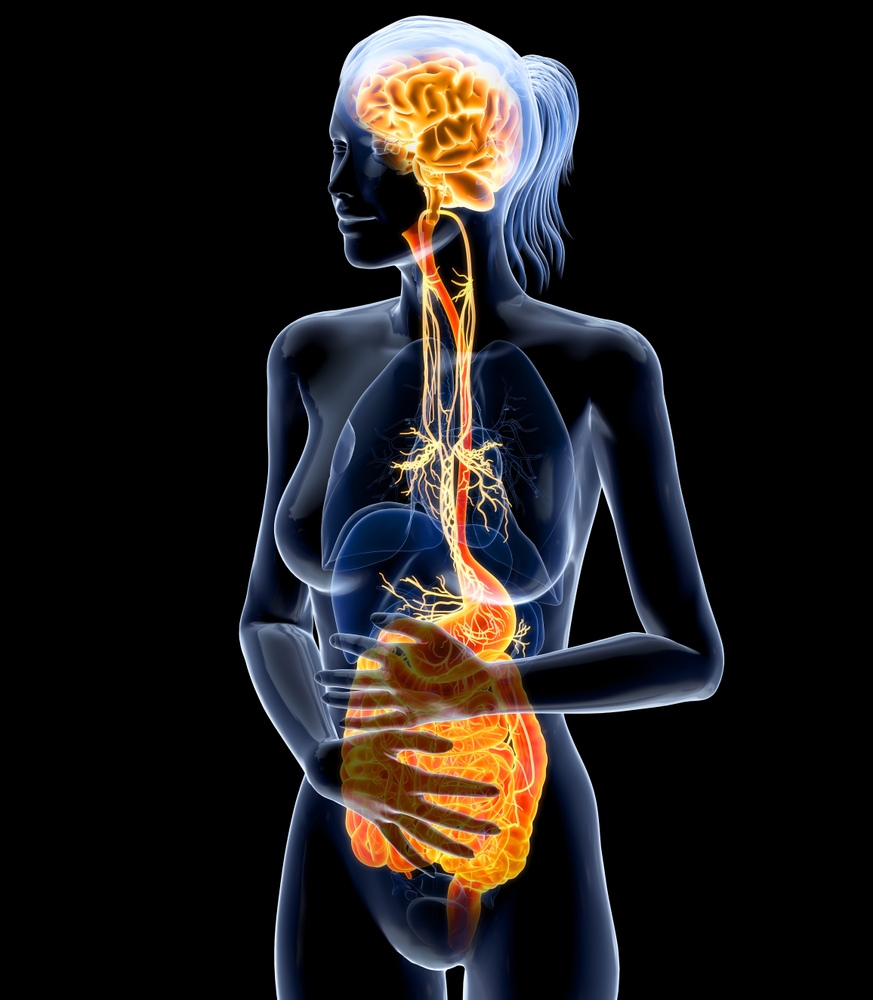
Alterations in gut microbiota composition, known as dysbiosis, have been associated with various neurological and psychiatric disorders, including depression, anxiety, and autism spectrum disorders. For instance, studies have demonstrated that germ-free mice exhibit altered stress responses and anxiety-like behaviors, which can be mitigated by introducing specific microbial species, highlighting the microbiota's role in modulating the gut-brain axis (Schächtle & Rosshart, 2021).
Furthermore, systemic inflammation resulting from gut dysbiosis may compromise the integrity of the blood-brain barrier, facilitating the entry of neurotoxic substances and contributing to neuroinflammation. This mechanism has been implicated in the pathogenesis of neurodegenerative diseases such as Alzheimer's disease.
How Stress Affects the Microbiome
Stress, whether psychological, environmental, or physical, can significantly alter the composition and function of gut microbiota, which in turn affects the host's stress response and overall health (Karl et al., 2018).The gut-brain axis, a complex communication network involving the gut microbiota, plays a crucial role in regulating stress-related responses, with diet being a significant modifying factor (Foster, Rinaman, & Cryan, 2017).
Stress-induced changes in the gut microbiota can lead to immune system activation and inflammation, which are linked to various stress-related conditions such as anxiety, depression, and irritable bowel syndrome (Buerel, 2024).
Moreover, early life stress has been shown to impact the gut microbiome, although consistent microbiome signatures associated with stress are yet to be identified (Agusti et al., 2023).
Chronic stress can exacerbate conditions like inflammatory bowel disease by disturbing the gut microbiota and triggering immune responses (Gao et al., 2018).
Protein Kinase C
Birnbaum and colleagues (2004) reported that uncontrollable stressful situations activate the enzyme protein kinase C (PKC), interfering with prefrontal cortical functions like working memory. Elevated PKC levels may result in symptoms of distractibility, impulsiveness, and poor judgment seen in bipolar disorder and schizophrenia. Initial psychotic episodes often follow stressors like leaving home for college or the military. Very low levels of lead exposure can elevate PKC levels in children, possibly impairing their regulation of behavior and producing distractibility and impulsivity.Stress Accelerates Aging
Epel and colleagues (2004) studied 58 healthy women who cared for either healthy or chronically ill children. The researchers administered a brief questionnaire that assessed chronic stress during the previous month and obtained a blood sample to measure telomere (DNA and protein that cover the ends of chromosomes), length, and levels of telomerase (an enzyme that adds DNA to telomeres). Graphic © Designua/Shutterstock.com.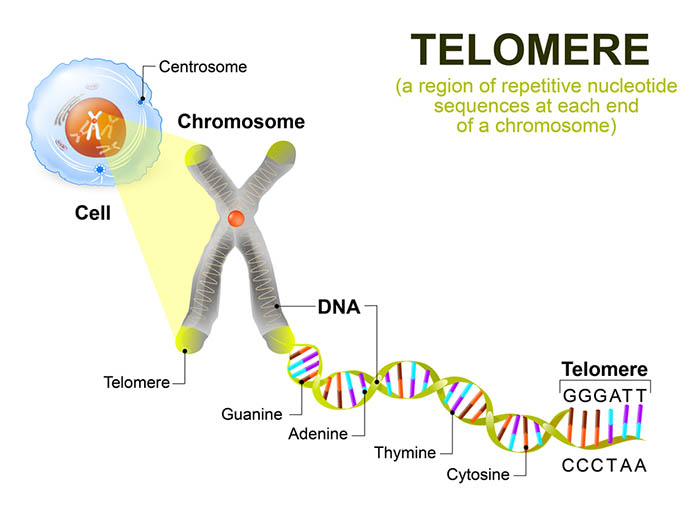
With repeated cell division, telomere DNA is lost, the telomere shortens, and eventually, cell division stops. When cells age, telomerase activity declines, and the telomere shortens. Graphic © koya979/ Shutterstock.com.
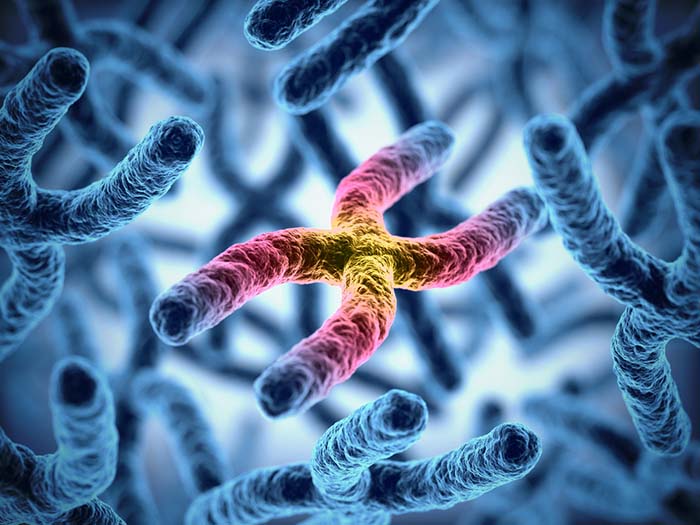
The researchers found that the mothers of chronically ill children reported higher chronic stress levels than mothers of healthy children. More years of caring for chronically ill children were correlated with shorter telomeres and lower telomerase levels. Perceived levels of chronic stress, and not a child's actual health status, predicted telomere length. The researchers calculated that the cells of high-stress mothers had aged 9 to 17 more years than those of the low-stress mothers.




